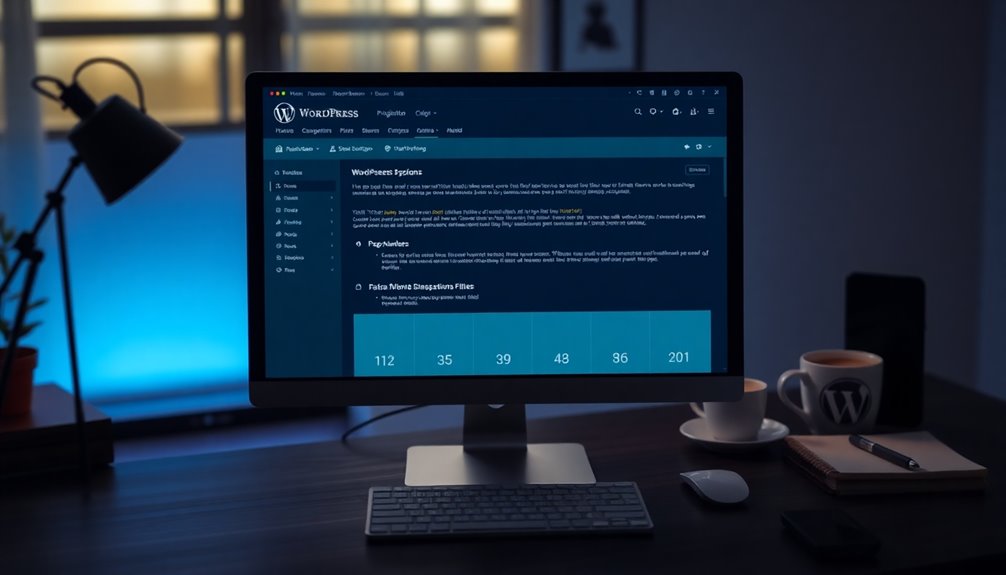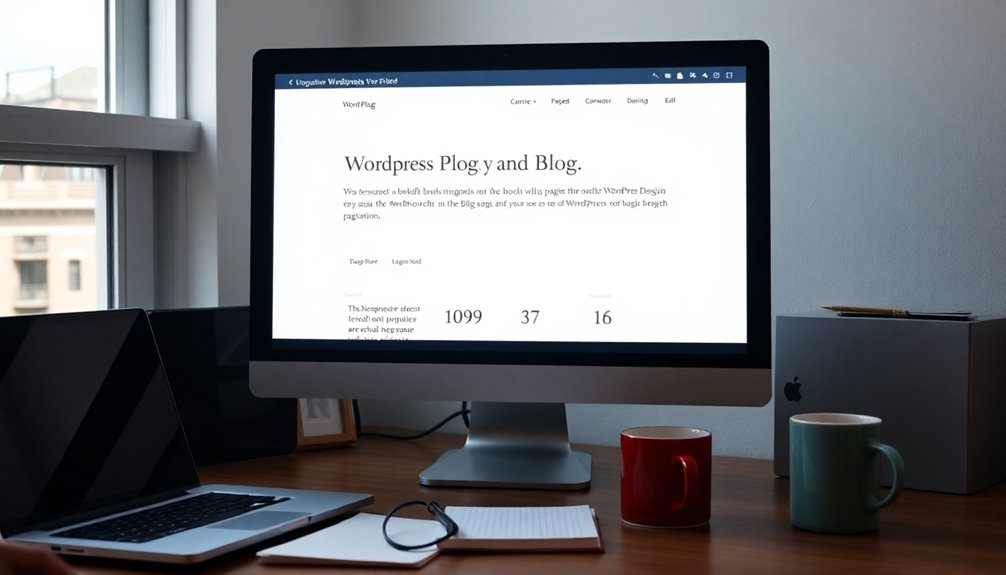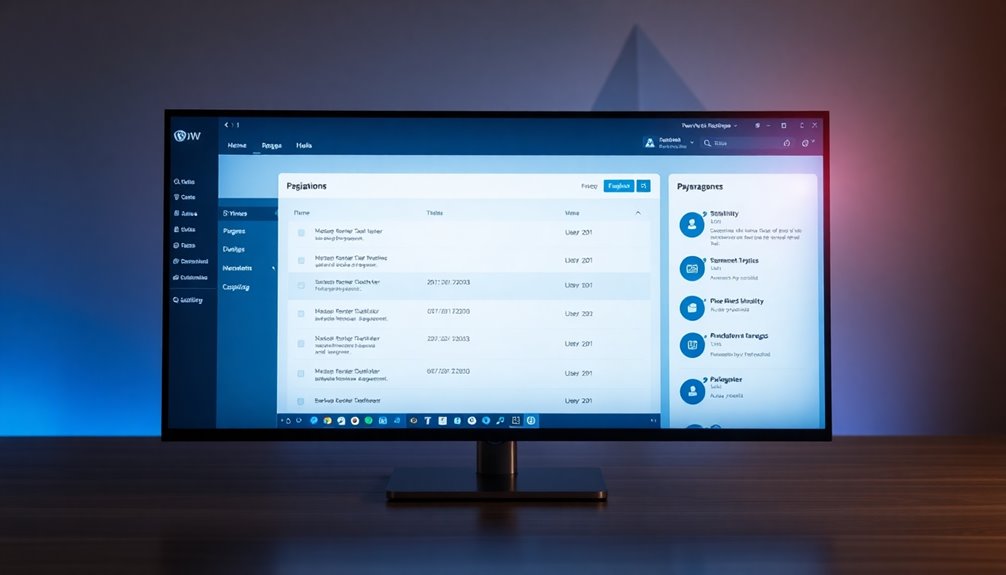Using pagination on your WordPress site can greatly enhance user experience. It breaks down large volumes of content into smaller, manageable sections, making navigation easier and faster. This not only encourages users to explore more but also reduces bounce rates, as they're less likely to feel overwhelmed. Properly implemented pagination improves your site's performance and aids in SEO by making content indexing clearer for search engines. You can customize pagination with plugins or manual coding to fit your site's style. Stick around, and you'll uncover more techniques and tips for mastering pagination and boosting user engagement.
Importance of Pagination
While you mightn't realize it, pagination plays an essential role in how users navigate your WordPress site. By breaking content into manageable sections, pagination enhances user experience and makes it easier for visitors to find relevant information. This organization improves performance, allowing pages to load faster, which keeps users engaged. When you implement effective pagination, you reduce bounce rates as users are encouraged to explore more posts or pages instead of feeling overwhelmed by excessive content on a single page. Additionally, proper pagination aids in search engine optimization. A clear content structure helps search engines crawl and index your site more efficiently, which can ultimately lead to better visibility in search results. Furthermore, using SEO plugins can enhance pagination effectiveness by optimizing how content is displayed and indexed. Implementing security plugins can also protect your site during extensive content management processes. Moreover, integrating caching plugins can significantly speed up page load times, further improving user experience and engagement.
Benefits of Pagination
Pagination offers numerous benefits that greatly enhance the user experience on your WordPress site. By providing various pagination options, you help users navigate through large volumes of content without feeling overwhelmed.
This improved navigation makes it easier for them to find relevant information quickly. Additionally, pagination can considerably improve loading times by breaking up content into manageable sections, leading to lower bounce rates and increased user engagement. Regular backups are crucial for maintaining website security and ensuring that your content is protected against data loss. Furthermore, a well-structured site with regular backups minimizes the risk of losing valuable content due to unforeseen events.
With clear navigation links and responsive layouts, you guarantee accessibility for all users, including those on mobile devices. Ultimately, effective pagination encourages visitors to explore older posts and additional content, increasing the likelihood of return visits and creating a more satisfying experience on your WordPress site. Furthermore, optimizing site structure enhances search engine indexing, which can lead to greater visibility and traffic to your content.
SEO Advantages

When you implement effective pagination on your WordPress site, you not only enhance user experience but also gain significant SEO advantages.
Proper pagination improves user navigation, reducing bounce rates and signaling to search engines that your content is engaging and relevant. It also offers pagination support, enabling search engines to crawl and index your content efficiently by minimizing the number of URLs on a single page. Additionally, many security breaches stem from outdated plugins, making it crucial to regularly update plugins for maintaining site integrity. Regularly updating plugins ensures optimal performance and compatibility with the latest WordPress version.
Adding rel=prev and rel=next tags helps search engines grasp the relationship between pages, boosting your visibility in search results. Furthermore, a well-structured pagination system enhances page load speeds, which search engines favor. Additionally, employing WordPress backup plugins can protect your site, ensuring that your content remains accessible and recoverable in case of data loss.
Ultimately, effective pagination encourages users to explore more content, increasing dwell time and reinforcing your site's authority and relevance.
User Experience Enhancement
Effective pagination serves as an essential tool in enhancing user experience on your WordPress site, as it organizes large volumes of content into easy-to-navigate sections. This organization prevents users from feeling overwhelmed, allowing them to explore your content more efficiently. Additionally, WordPress file upload plugins can be utilized to manage and enhance your content presentation. Regular backups protect data from data loss, ensuring your content remains accessible and organized.
By breaking content into smaller parts, pagination can considerably reduce load times, contributing to a smoother browsing experience. Clear navigation links within pagination systems help users find the information they seek quickly, improving content discovery and engagement.
Additionally, implementing responsive pagination designs guarantees that your site remains user-friendly on all devices, particularly for mobile users. Ultimately, effective pagination lowers bounce rates by facilitating easier access to older posts, encouraging users to dive deeper into your content. Furthermore, having a well-structured WordPress installation process can further enhance the overall user experience on your site.
Performance Improvement

A well-structured pagination system not only enhances user experience but also greatly boosts site performance.
By implementing pagination, you reduce the amount of data loaded at once, leading to faster loading pages. This minimizes server load, making your site more efficient and responsive. Efficiently configured databases can significantly contribute to faster page loading by optimizing how data is retrieved. Additionally, a reliable backup strategy ensures that your site can recover quickly in case of any performance issues or data loss.
Improved WordPress pagination helps organize content effectively, allowing users to navigate without feeling overwhelmed. As a result, you'll see higher user engagement since visitors are less likely to abandon your site due to long wait times.
Additionally, pagination reduces simultaneous requests to the server, enhancing response times and site reliability during peak traffic. Proper database configuration essentials ensure that your pagination system operates seamlessly, contributing to overall site performance.
Ultimately, these performance improvements create a smoother experience that keeps users coming back for more.
Built-in Pagination Features
While traversing a content-heavy site, users appreciate the ease that built-in pagination features in WordPress provide. These features automatically split your posts into multiple pages, allowing users to easily navigate through your content.
The default pagination format uses numeric links, making it simple for visitors to jump to specific pages. You can improve pagination using WordPress settings to customize the number of posts displayed per page, enhancing load times and overall user experience.
For developers, functions like 'paginate_links()' offer the chance to create custom pagination controls tailored to your needs. By leveraging WordPress's built-in pagination features, you not only improve site organization but also boost SEO, ensuring search engines can efficiently crawl and index your content.
Using WP-PageNavi Plugin

If you're looking to enhance your site's pagination, the WP-PageNavi plugin is an excellent choice. This plugin generates numeric pagination links, making it easy for your visitors to navigate large volumes of posts.
With its customizable settings, you can modify page number texts, current page labels, and first/last page naming to improve navigation clarity.
Integrating the WP-PageNavi plugin into your existing theme is simple; just replace the default Next and Previous links with the '' function in your template files.
Plus, it offers extensive styling options, enabling you to align the pagination design with your branding through CSS customization.
Ultimately, using WP-PageNavi contributes to a Better User Experience on your site.
Manual Pagination Implementation
When you implement manual pagination in WordPress, you'll need to edit your theme's 'functions.php' file and adjust the 'index.php' or 'archive.php' files to add pagination code.
This approach not only gives you control over how pagination looks and functions but also allows for style customization through your 'style.css' file.
Plus, testing your changes across different devices guarantees a smooth experience for all users.
Code Integration Techniques
To enhance user experience on your WordPress site, implementing manual pagination can be a game-changer.
You'll start by editing your theme's 'functions.php' file and modifying template files like 'index.php' or 'archive.php' to include custom pagination code. By replacing the default loop with the_posts_pagination) function, you can effectively split your content into multiple pages.
This approach not only improves pagination but also makes navigation easier for users. Make certain your code respects the WordPress query and manages pagination variables like 'paged' for seamless functionality.
Don't forget to test your manual pagination across various devices and browsers, confirming that it operates smoothly and enhances the overall user experience on your site.
Style Customization Options
Customizing the style of your manual pagination can greatly enhance the visual appeal and usability of your WordPress site.
Start by editing your theme's 'style.css' file to apply custom CSS rules for pagination elements like buttons and links. You can create unique pagination looks by adjusting colors, fonts, and hover effects.
Using functions like 'paginate_links()' within your pagination code gives you better control over the display.
Don't forget to verify your pagination design is responsive; it should adapt seamlessly across various devices and screen sizes.
Finally, test your implementation thoroughly across different browsers to make sure everything works smoothly, maintaining a consistent user experience that keeps visitors engaged.
Styling Pagination

Styling pagination isn't just about aesthetics; it plays an essential role in enhancing user experience on your WordPress site.
With CSS customization, you can create pagination that aligns perfectly with your branding. Consider various styles, like rounded buttons or minimalistic designs, to improve user interaction.
Implementing responsive design guarantees your pagination elements adjust seamlessly across devices, providing a consistent experience on both desktop and mobile.
Custom color schemes can enhance visibility, drawing attention to navigation elements and boosting usability.
Additionally, adding hover effects to your pagination buttons creates a more interactive experience, encouraging users to engage effectively with your navigation links.
Navigational Best Practices
While traversing a website, users appreciate clear and intuitive pathways, so implementing effective navigational best practices is vital for enhancing their experience.
Start by clearly labeling pagination links like "Previous" and "Next" to aid user navigation. Numeric pagination is also fundamental, allowing users to jump to specific pages for better content discovery without frustration.
Make certain that pagination controls are consistently placed across all pages to create a familiar browsing experience. Adding breadcrumb navigation helps users understand their location within the site's hierarchy, making navigation easier.
Finally, embrace responsive design principles to guarantee pagination elements work seamlessly on all devices, especially as mobile traffic continues to rise.
These practices collectively lead to a more satisfying user experience.
Testing Pagination Functionality

When testing pagination functionality, you need to verify it works seamlessly across different browsers and devices.
Check for mobile responsiveness to confirm your users have a smooth experience, no matter how they access your site.
It's crucial to catch any issues early so you can provide the best navigation possible.
Cross-Browser Compatibility Check
How can you guarantee a seamless pagination experience for users across different browsers?
Start by conducting thorough testing of pagination functionality on major browsers like Chrome, Firefox, Safari, and Edge. This guarantees consistent user experience and interface performance.
Utilize browser developer tools to spot any JavaScript errors or CSS inconsistencies that could affect pagination display and functionality.
Adjust browser window sizes to test pagination responsiveness and confirm that navigation elements adapt appropriately.
It's essential to verify that pagination links load the correct pages and maintain state during navigation.
Finally, regularly update your WordPress version and plugins to benefit from compatibility improvements, minimizing potential pagination issues and enhancing overall user experience across various browsers.
Mobile Responsiveness Assessment
Guaranteeing pagination works smoothly across different browsers sets a strong foundation, but testing on mobile devices is equally important for a seamless user experience.
With over 50% of web traffic coming from mobile users, check that your pagination buttons are adequately sized and spaced on mobile screens to avoid frustrating users. Aim for touch targets of at least 44×44 pixels.
Implement responsive design to guarantee pagination adapts to various screen sizes while maintaining readability. Use browser developer tools to test pagination across multiple devices and screen resolutions, identifying any layout issues.
Finally, conduct regular user testing on mobile devices to gather feedback on pagination effectiveness, allowing you to make iterative improvements based on real user interactions.
Mobile Optimization Strategies
To improve the user experience on mobile devices, it's crucial to implement effective pagination strategies that cater to smaller screens.
Here are some key mobile optimization strategies to take into account:
- Use responsive design principles for seamless pagination element adjustments.
- Limit pagination links to 3-5 to avoid overwhelming users.
- Implement touch-friendly buttons to guarantee easy navigation on mobile.
- Take into account AJAX pagination for seamless content loading without page refreshes.
- Optimize loading times by minimizing content per page, especially for slower connections.
Future Pagination Trends

As you look to the future of pagination, consider how mobile-first design is reshaping user experiences on smartphones and tablets.
You'll also want to explore AI-driven recommendations that can tailor pagination to fit individual user behaviors and preferences.
These trends promise to make content navigation more intuitive and engaging for your audience.
Mobile-First Design Focus
While mobile-first design has become essential in today's digital landscape, its impact on pagination trends can't be overlooked.
You need to optimize pagination on your WordPress site to enhance the mobile experience. Consider the following trends:
- Swipe gestures for easier navigation
- Larger buttons for better user interaction
- Lazy loading to improve load times
- Responsive layouts that adapt to various screen sizes
- Clear navigation elements for seamless access to content
AI-Driven Recommendations Integration
Integrating AI-driven recommendations into your pagination strategy can greatly elevate user experience on your WordPress site. By utilizing pagination using machine learning algorithms, you can create custom pagination that adapts to user behavior in real-time.
This personalization enhances content discovery based on individual preferences, helping to improve user experience. Predictive analytics allow you to identify which pages users are likely to visit next, streamlining navigation and keeping users engaged.
Additionally, AI can segment user demographics and interests, leading to more relevant pagination structures that reduce bounce rates. With enhanced analytics, you gain insights into user interaction with pagination, enabling continuous optimization for a more satisfying browsing experience over time.
Resources for Further Learning
Enhancing your knowledge of pagination in WordPress can greatly improve user experience on your site.
To deepen your understanding and skills, check out these valuable resources:
- "Learn WordPress from Scratch" ebook: Offers foundational knowledge and practical tips on pagination.
- WordPress.org community forums: Connect with experienced users for best practices and insights.
- Comprehensive guides and tutorials: Step-by-step instructions for manual and plugin-based pagination setups.
- Online courses: Enroll in courses focused on WordPress functionalities, including pagination techniques.
- Blogs and articles: Stay updated with the latest tips and trends for optimizing pagination on your WordPress site.
Conclusion
Incorporating pagination into your WordPress site isn't just a design choice; it's a powerful tool for enhancing user experience. By breaking content into manageable chunks, you invite visitors to engage more deeply. Plus, the SEO benefits can't be overlooked. As you embrace these strategies, keep an eye on future trends to stay ahead. Remember, a well-optimized site isn't just about aesthetics; it's about creating a seamless journey for your users. So, let pagination work its magic!



